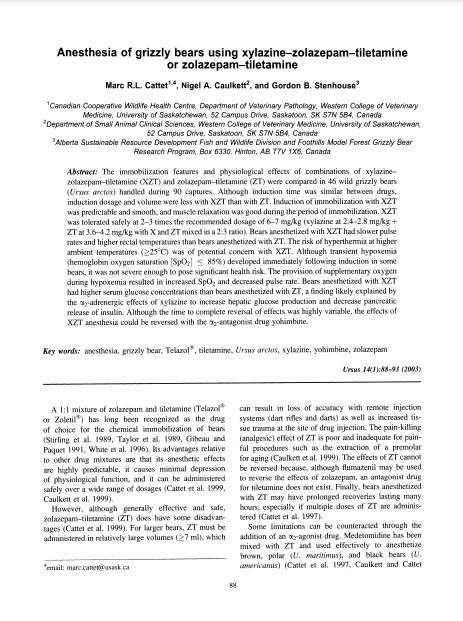Anesthesia of Grizzly Bears Using Xylazine-zolazepam-tiletamine or Zolazepam-tiletamine
Bosque Modelo:
Foothills
Temática:
Gestión forestal
Tipo de documento:
Artículo científico
Resumen
: The immobilization features and physiological effects of combinations of xylazinezolazepam-tiletamine (XZT) and zolazepam-tiletamine (ZT) were compared in 46 wild grizzly bears (Ursus arctos) handled during 90 captures. Although induction time was similar between drugs, induction dosage and volume were less with XZT than with ZT. Induction of immobilization with XZT was predictable and smooth, and muscle relaxation was good during the period of immobilization. XZT was tolerated safely at 2-3 times the recommended dosage of 6-7 mg/kg (xylazine at 2.4-2.8 mg/kg + ZT at 3.6-4.2 mg/kg with X and ZT mixed in a 2:3 ratio). Bears anesthetized with XZT had slower pulse rates and higher rectal temperatures than bears anesthetized with ZT. The risk of hyperthermia at higher ambient temperatures (>25?C) was of potential concern with XZT. Although transient hypoxemia (hemoglobin oxygen saturation [SpO2i < 85%) developed immediately following induction in some bears, it was not severe enough to pose significant health risk. The provision of supplementary oxygen during hypoxemia resulted in increased SpO2 and decreased pulse rate. Bears anesthetized with XZT had higher serum glucose concentrations than bears anesthetized with ZT, a finding likely explained by the ca2-adrenergic effects of xylazine to increase hepatic glucose production and decrease pancreatic release of insulin. Although the time to complete reversal of effects was highly variable, the effects of XZT anesthesia could be reversed with the 0c2-antagonist drug yohimbine.
Información Bibliográfica
Autor:
Cattet, MRL, NA Caulkett and GB Stenhouse.
Revista:
Ursus
Año:
2003
N°:
1
País :
Canadá
Páginas:
88 - 93
Volumen:
14
Idioma:
Ingles
Palabras claves
anesthesia, grizzly bear, TelazolR, tiletamine, Ursus arctos, xylazine, yohimbine, zolazepam





